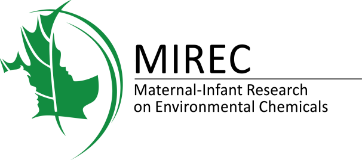
Determination of free and total bisphenol A in human milk samples from Canadian women using a sensitive and selective GC-MS method.
Cao X-L, Popovic S, Arbuckle TE, Fraser WD. Food Additives and Contaminants. 2015;32(1):120-5. doi: 10.1080/19440049.2014.980855
Canadians have become increasingly aware in recent years of the widespread presence of bisphenol A (BPA) in the environment, particularly in commonly used products found in many Canadian homes. For example, BPA is used to make a hard, clear plastic and may also be found in epoxy resin linings on the inside of metal-based food and beverage cans. Thermal papers such as receipts and tickets may also be a source of BPA. Infants may be exposed to BPA through their mothers’ breast milk.
To have a better understanding of the levels of BPA in mothers’ breast milk, researchers at Health Canada developed and used a novel and precise laboratory method to analyze 278 milk samples collected from the MIREC Study participants. Total BPA was found in only 26% of the samples, while the more biologically active form of BPA, known as “free BPA”, was detected in 16.5% of the milk samples.
Furthermore, the levels of free and total BPA in most of the human milk samples were low, and they were also lower than those reported in other countries. As well, based on the low rate of detection of the more active form of BPA (“free” BPA) in the samples, the researchers stated that, “in general, dietary exposure to BPA for Canadian breast-fed infants is expected to be somewhat lower compared with exposure among formula-fed infants.”
Note: for more information on the MIREC Study participants, see the Cohort Profile: the Maternal-Infant Research on Environmental Chemicals Research Platform.
MIREC Année all rights reserved - Privacy policy
Website by Riposte


